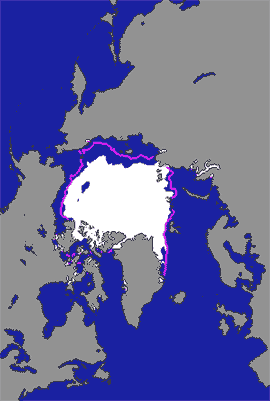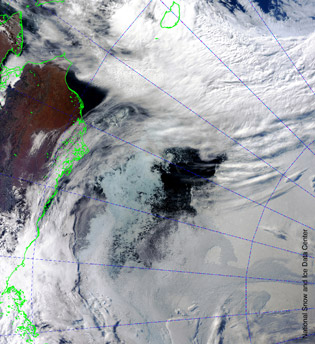 |
 |
 |
 |
 |
 |
 |
 |
 |
 |
|
|
|

Arctic summer sea ice falls below normal for fifth year, despite a cool August |
4 October 2006The pattern of sharply decreasing Arctic sea ice continued in 2006, raising further concern that the Arctic is responding to global warming. Matt Serreze, senior research scientist at the National Snow and Ice Data Center in Boulder, Colorado said, “If fairly cool and stormy conditions hadn’t appeared in August, slowing the rate of summer ice loss, I feel certain that 2006 would have surpassed last year’s record low for September sea ice.” The melting season ended on September 14, the date of the sea ice minimum, when Arctic sea ice covered 5.7 million square kilometers (2.2 million sq.miles). It is the fourth lowest in the 29-year satellite record for a single day. |
Arctic summer sea ice has been in steep decline since 2002 with a record 2005 low. |
|
The average sea ice extent for the month of September was 5.9 million sq.km (2.3 million sq.miles), the second lowest on record, missing the 2005 record by 340,000 sq.km. The rate of sea ice decline is now 8.6 percent per decade, or 60,421 sq.km (23,328 sq.miles) per year. NSIDC research scientist Julienne Stroeve said, “At this rate, the Arctic Ocean will have no ice in September by 2060." |
 |
The average sea ice extent for September 2006 is shown in white. The magenta line indicates the average September extent from 1979 to 2000.Image from NSIDC Sea Ice Index |
|
Ice extent from January to mid-July 2006 was well below 2005 conditions, which if it had continued would have led to a new record low. Low sea ice through mid-July was consistent with very warm air temperatures. Serreze said, “high temperatures over the winter helped limit ice growth so that less ice formed. Much of the ice that did grow was probably thinner than normal. Unusually high temperatures through most of July then fostered rapid melt.” Lower air temperatures in August broke the Arctic heat wave and slowed the melt, and storm conditions led to wind patterns that tend to spread the existing ice over a larger area. Temperatures returned to above-normal in September. The warmer temperatures have meant a slow recovery from the September minimum. |
 |
An unusual polynya, an area of open water surrounded by ice in the center of the image, formed during the melt season in the Beaufort Sea. To the left is the coastline of Alaska, showing fall foliage color, and to the bottom right is the North Pole.
|
 |
 Rapid changes in Arctic sea ice
Rapid changes in Arctic sea ice
 View larger image
View larger image